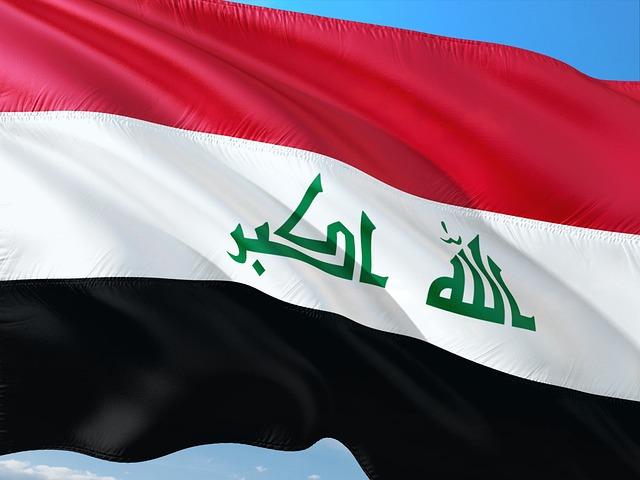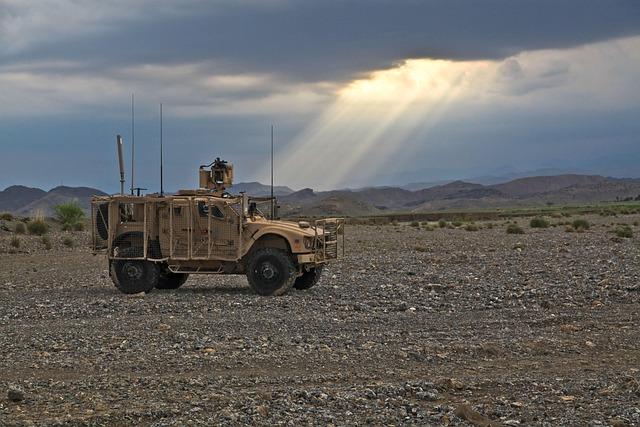In the complex tapestry of Middle Eastern geopolitics, the recent escalation of U.S. military actions against the Iran-aligned Houthi movement in Yemen has sent shockwaves throughout the region, notably among iran-backed militias in Iraq. These groups, which have been long-standing allies of Tehran, find themselves navigating a precarious landscape marked by shifting allegiances and rising tensions. As the U.S. intensifies its focus on countering Iranian influence through targeted strikes,Iraqi militias face a dual challenge: responding to external threats while maintaining their own strategic objectives amid regional uncertainty. This article delves into the implications of the U.S. military’s actions in Yemen on Iraq’s Iran-backed factions, exploring how an evolving conflict on one front may reshape the dynamics of power and resistance in another.
Iraq’s Iran-Backed Militias React to escalating U.S. Strikes in the Region
The recent surge in U.S. military strikes targeting Iranian-affiliated forces has triggered palpable tension among iraq’s militias that operate under Iran’s influence. These groups have long viewed themselves as the guardians of their sovereign interests but are now grappling with the implications of American actions that extend beyond the immediate battlefield in Iraq. Reports indicate that these militias are reassessing their strategies, bolstering defenses, and preparing for potential retaliatory measures should U.S. operations escalate further. Key factors shaping their response include:
Enhanced military coordination with Tehran: Increased efforts to coordinate military and intelligence activities with the Iranian Revolutionary Guard Corps.
Mobilization of local support: Aiming to rally pro-Iranian factions and communities against perceived foreign aggression.
Preemptive strikes: Considering initiating operations to deter U.S.troops from expanding their reach within Iraq.
In the wake of these developments, greater scrutiny has fallen on the geopolitical ramifications of U.S.-Iran tensions. Analysts underline how the situation could further entrench sectarian divides within Iraq, potentially destabilizing the already fragile political landscape. Some factions within the militias argue that the escalation of hostilities will only serve to bolster the U.S. military presence, leading to a more entrenched conflict. A deeper understanding of this dynamic is evident in the following table highlighting potential outcomes:
Potential Outcomes
Impacted Groups
Increased U.S. Presence
Iraq-based militias
Strengthened Iran-Iraq Relations
Iranian regime, pro-Iran factions
Heightened Sectarian Tensions
Iraqi Sunni populations

The Implications of U.S. Military actions in Yemen for Iraqi Proxy Forces
The recent U.S.military actions against Houthi targets in Yemen have reverberating effects across the region, particularly influencing the dynamics of Iraqi proxy forces backed by Iran. The terror of U.S. intervention presents a dual-edged sword for these militias as they assess their operational strategies and political loyalties. With U.S. strikes aimed at curbing Iranian influence in Yemen, Iraqi militias find themselves in a precarious position, grappling with increased scrutiny and potential alignment with Iranian objectives in the region. As they navigate this complex landscape, concerns about sustained U.S. countermeasures loom large, prompting these groups to reassess their own military engagements and strategic partnerships.
Moreover, the implications of these strikes extend beyond immediate military calculations, igniting debates within the Iraqi militia ranks about their long-term objectives. The fractious nature of these groups, coupled with their allegiance to iranian ideology, raises critical questions about their ability to remain cohesive amid external pressures. Factors influencing their response include:
Increased U.S. Support for Regional RivalsShifts in Iranian StrategyPotential for U.S.-Iran Escalation
Furthermore, the following table summarizes key points regarding the context of U.S. actions in Yemen and its potential impact on iraqi militias:
Factor
Impact on Iraqi Militias
U.S. military actions
Heightened operational risk
Iran’s response
Strategic realignment needed
Domestic pressure
Increased scrutiny from Iraq’s government

Analyzing the strategic Shifts Among Iran’s Militant Groups in Iraq
The recent escalation of US military operations against the houthis in yemen has sent ripples through Iran’s extensive network of militias in Iraq. These groups are grappling with the consequences of heightened scrutiny and potential countermeasures from American forces, which not only affect their operational capabilities but also their strategic posture within the region. Amid the shifting geopolitical landscape, Iranian-backed militias are faced with the dilemma of recalibrating their tactics and alliances to maintain influence. Key factors influencing these shifts include:
Increased US Presence: The possibility of direct US engagement in Iraq may compel militias to adopt more clandestine operations.
Proxy Dynamics: Interactions between different militias are evolving, with some factions seeking to reposition themselves in the light of changing Iranian strategies.
Local Political Climate: Local governance and public sentiment may sway these groups’ decisions, perhaps leading them to reconcile differences to maintain regional relevance.
As these dynamics unfold,the potential for fragmentation among Iran’s proxies could increase. Ancient alliances may unravel, giving way to new coalitions oriented around shared interests rather than ideology. In this complex chess game, the response of these militias will be crucial in determining Iraq’s overall stability. They must navigate a landscape filled with opportunities and threats that compel them to either unify their efforts against external threats or risk internal disintegration.Below is a table summarizing some of the prominent Iranian-backed militias and their observed strategic shifts:
Militia Group
Strategic Shift
Harakat al-Nujaba
Increased focus on guerrilla tactics against US forces.
Asa’ib Ahl al-Haq
Strengthening ties with local political entities to gain leverage.
Kata’ib Hezbollah
Adopting a lower profile while preparing for potential conflict escalation.

Potential Consequences for Stability in Iraq Amid Rising Tensions
The recent strike by the US on Houthi positions in Yemen has not only escalated tensions within the region,but it could also act as a catalyst for instability in Iraq,particularly concerning Iran-backed militias. These groups, which have significant influence in Iraqi politics and military operations, might perceive the US action as a direct threat, igniting fears of retaliation against American personnel or interests in Iraq. As a result, we may witness an increase in militia activities, including possible attacks on US forces or their allies, which can further entrench sectarian divides and provoke a surge in violence across the country.
Moreover, the heightened military engagement in neighboring Yemen could drive a wedge between the various factions within Iraq, particularly as Iran seeks to consolidate its influence through its proxies. The potential consequences of this realignment could include:
Increased hostility: Escalating militia operations against rival factions or external forces.
Political fragmentation: A rift among political parties over how to respond to perceived US aggressions.
Humanitarian Crisis: Potential for renewed conflict leading to civilian displacement and suffering.

Recommendations for Regional Actors Amidst Heightened Conflict Dynamics
In light of the escalating tensions and shifting power dynamics in the region, it is crucial for regional actors to adopt multifaceted strategies that prioritize stability and peace.Engagement with various stakeholders, including local communities and rival factions, should be emphasized to foster dialog and reduce hostilities. By leveraging diplomatic channels and encouraging collaborative initiatives, regional powers can work towards de-escalation and long-term solutions that transcend immediate conflicts. Moreover, enhancing intelligence-sharing mechanisms among allies will aid in understanding adversaries’ strategies, thereby allowing for informed decision-making and responses to emerging threats.
Additionally, regional actors must consider the importance of economic resilience as part of their conflict response strategy. By investing in local economies and promoting sustainable advancement projects, they can address the root causes of discontent that often fuel conflict. Key recommendations include:
Strengthening community ties to unify diverse groups against common threats.
Encouraging inclusive governance that incorporates voices from marginalized communities.
Implementing conflict resolution training for leaders and civil society organizations.
Prioritizing humanitarian aid to alleviate the dire conditions faced by affected populations.
Moreover, establishing a regional conflict-monitoring task force could facilitate better understanding and timely intervention in escalating situations. Below is a proposed structure for a potential task force:
Component
Description
Analysis Unit
Monitors conflict trends and assesses risk factors.
Diplomatic Outreach
Engages with local leaders and international stakeholders.
humanitarian Coordination
streamlines aid delivery and resource allocation.
Public Dialogue
Informs the public to combat disinformation and promote peace.

The Way Forward
As the geopolitical landscape in the Middle East continues to evolve, the increasing pressure on Iran-backed militias in Iraq reflects a broader regional tension exacerbated by the U.S. military’s recent actions against Houthi forces in Yemen. These developments not only highlight the fragile balance of power in the region but also raise concerns about potential repercussions for stability in Iraq and beyond. Amid heightened security concerns and shifting alliances,the Iraqi militias find themselves at a crossroads,navigating a complex interplay of local and international influences. As stakeholders on all sides assess the implications of these events, the potential for renewed conflict or diplomatic engagement remains uncertain. The unfolding situation demands close attention as it will undoubtedly influence the trajectory of U.S.-Iran relations and the broader strategic dynamics in the Middle East.The road ahead is fraught with challenges,and the actions taken by various players in the coming weeks will be critical in shaping the future of the region.
—-
Author : Asia-News
Publish date : 2025-03-18 01:05:38
Copyright for syndicated content belongs to the linked Source.